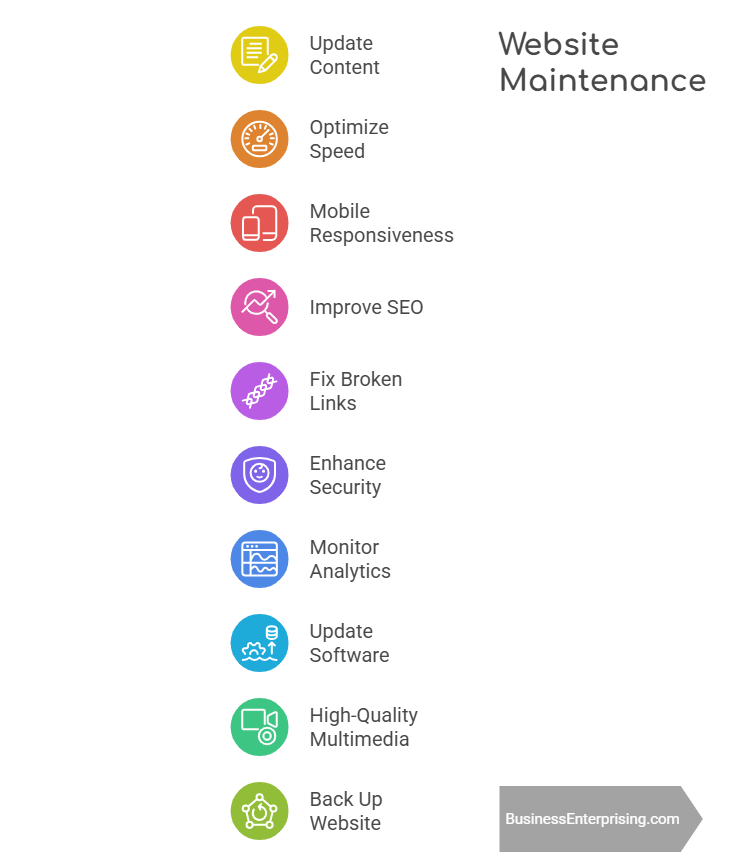
Regular updates enhance user experience by ensuring content remains relevant and engaging. Fresh content not only keeps your audience informed but also signals to search engines that your site is active, potentially improving your search rankings. Additionally, routine maintenance addresses technical issues such as broken links or slow loading times, which can frustrate users and drive them away.
Security is another critical aspect of website maintenance. Regularly updating software and plugins helps protect your site from vulnerabilities and cyber threats. Neglecting these updates can lead to security breaches, compromising both your business and customer data.
Incorporating multimedia elements like videos and infographics can further enrich user engagement. These features make your content more dynamic and appealing, catering to diverse audience preferences. However, it’s essential to optimize these elements to maintain site speed and performance.
Monitoring website analytics provides valuable insights into user behavior and site performance. By analyzing metrics such as bounce rates and traffic sources, you can make informed decisions to refine your content and design. This data-driven approach ensures your website evolves in line with user expectations and industry trends.
Ultimately, consistent website updates and maintenance are foundational to sustaining a robust online presence. They contribute to improved user satisfaction, higher search engine rankings, and fortified security. By prioritizing these efforts, you position your business for ongoing digital success.
Why Regular Website Updates Are Essential for Business Success
Regularly updating and maintaining a business website is essential for your company’s success. An outdated website can negatively affect user experience and diminish your brand’s credibility. Visitors encountering obsolete content or design may perceive your business as neglectful or unprofessional. This perception can lead to increased bounce rates and lost opportunities. Therefore, keeping your website current is crucial.
Search engines, such as Google, prioritize websites that offer fresh, relevant content. Regular updates signal to search engines that your site is active and valuable to users. Consequently, this practice can improve your search engine rankings, making it easier for potential customers to find you. Incorporating new blog posts, articles, or product updates not only engages visitors but also enhances your site’s visibility.
Moreover, a well-maintained website enhances user experience by ensuring smooth navigation and fast load times. Users appreciate websites that are easy to navigate and responsive across devices. Regular maintenance helps identify and fix issues that could hinder usability, such as broken links or outdated plugins. By addressing these aspects, you create a positive impression and encourage visitors to stay longer, increasing the likelihood of conversions.
Updating and maintaining a business website is a fundamental aspect of your digital strategy. It not only bolsters your brand’s credibility but also improves search engine rankings and user satisfaction. By investing time and resources into regular updates, you position your business for sustained online success.
Website Security: Protecting Your Business and Customer Data
Protecting your business and customer data is paramount. Regularly updating and maintaining a business website plays a significant role in safeguarding against cyber threats. Timely installation of security updates addresses known vulnerabilities, reducing the risk of exploitation by malicious actors. Neglecting these updates can leave your website susceptible to attacks, potentially compromising sensitive information.
Implementing SSL certificates is another critical aspect of website security. SSL (Secure Socket Layer) certificates encrypt data transmitted between your website and its visitors, ensuring that sensitive information remains confidential. This encryption not only protects user data but also fosters trust, as visitors are more likely to engage with websites that display secure connections.
To further safeguard against cyber threats, adopting best practices is essential. Utilizing strong, unique passwords for all accounts minimizes the risk of unauthorized access. Regularly backing up your website’s data ensures that you can recover information in the event of a breach or data loss. Additionally, employing firewalls and intrusion detection systems can help monitor and control incoming and outgoing network traffic, blocking potential threats before they cause harm.
Educating your team about cybersecurity is also vital. Training employees to recognize phishing attempts and avoid suspicious links can prevent many common attacks. Encouraging a culture of security awareness ensures that everyone plays a part in protecting your business’s digital assets.
Incorporating these measures into your routine website maintenance not only protects your business but also assures your customers that their data is secure. By proactively addressing potential vulnerabilities, you create a safer online environment for all users.
Optimizing Website Performance for Speed and Mobile Friendliness
Optimizing your website’s performance is essential for delivering a seamless user experience and improving search engine rankings. Website loading speed significantly impacts how users interact with your site. Slow-loading websites often frustrate visitors, leading them to abandon the site in favor of faster alternatives. This behavior increases bounce rates and reduces the time users spend on your site, negatively affecting user engagement and conversion rates. Additionally, search engines like Google consider page speed a ranking factor; faster sites are more likely to rank higher in search results. Therefore, regularly updating and maintaining a business website to enhance loading speeds is crucial for retaining users and achieving better SEO performance.
Ensuring mobile responsiveness is equally important in today’s digital landscape. With a significant portion of web traffic originating from mobile devices, your website must adapt seamlessly to various screen sizes and orientations. A mobile-responsive design adjusts layouts, images, and functionalities to provide an optimal viewing experience across devices. This adaptability enhances user satisfaction, as visitors can easily navigate and interact with your site regardless of the device they use. Moreover, search engines favor mobile-friendly websites, further boosting your site’s visibility and ranking. By prioritizing both speed and mobile responsiveness, you create a user-centric website that meets the expectations of modern users and search engines alike.
Incorporating performance optimization and mobile responsiveness into your website maintenance routine not only improves user experience but also contributes to your site’s overall success. Regular assessments and updates ensure that your website remains competitive and continues to meet evolving user needs. By focusing on these aspects, you lay a solid foundation for sustained growth and engagement in the digital realm.
Updating Content to Keep Your Website Relevant and Engaging
Keeping your website’s content fresh is essential for maintaining relevance and engaging your audience. Regularly updating blog posts, product descriptions, and service pages ensures that visitors receive accurate information, fostering trust in your brand. Refreshing content can also improve search engine rankings, as search engines favor up-to-date information. By updating and maintaining a business website, you demonstrate commitment to providing value, which can lead to increased customer loyalty.
To refresh your content effectively, start by conducting a content audit to identify outdated or underperforming pages. Updating statistics, revising language, and incorporating recent developments can breathe new life into old posts. For product descriptions and service pages, highlighting new features or benefits can attract potential customers. Additionally, repurposing existing content into different formats, such as turning a blog post into a video or infographic, can reach diverse audience preferences.
Incorporating multimedia elements like videos, images, and infographics significantly enhances user engagement. These elements break up large blocks of text, making content more digestible and visually appealing. Videos can demonstrate product usage or share customer testimonials, providing dynamic insights. Infographics present complex information succinctly, aiding comprehension. Moreover, multimedia content can improve SEO rankings by increasing time spent on your site and reducing bounce rates.
By focusing on content updates and integrating multimedia, you create a dynamic website that resonates with visitors. This approach not only keeps your audience informed but also encourages repeat visits and shares, amplifying your online presence. Regularly assessing and refreshing your website content is a strategic investment in your brand’s ongoing success.
SEO Best Practices for Website Maintenance
Regularly updating and maintaining a business website is essential for effective search engine optimization (SEO). One key aspect involves updating keywords and meta descriptions. As search trends evolve, your target keywords may change, affecting your site’s relevance. Regularly revisiting and updating your keywords ensures alignment with current user search behavior. Similarly, well-crafted meta descriptions provide concise summaries of your pages, influencing click-through rates. By incorporating targeted keywords into these descriptions, you enhance their effectiveness. Therefore, keeping both elements current is vital for maintaining visibility and attracting qualified traffic.
Another crucial SEO practice is fixing broken links and optimizing site structure. Broken links, resulting from moved or deleted pages, can frustrate users and impede search engine crawlers. Regularly auditing your site to identify and repair these links improves user experience and ensures efficient indexing. Additionally, a well-organized site structure enhances navigation and helps search engines understand content hierarchy. Implementing a logical internal linking strategy distributes authority across pages, boosting overall rankings. Consequently, addressing these technical aspects is fundamental for a robust SEO strategy.
Incorporating these SEO best practices into your website maintenance routine not only enhances search engine performance but also enriches user engagement. By staying proactive in updating keywords, refining meta descriptions, repairing broken links, and optimizing site architecture, you create a seamless and informative experience for visitors. This comprehensive approach to website upkeep ensures sustained growth and competitiveness in the digital landscape.
Monitoring Website Analytics and Performance Metrics
Monitoring your website’s analytics is essential for understanding user behavior and enhancing site performance. Key metrics to track include bounce rate, conversion rates, and traffic sources. Bounce rate measures the percentage of visitors who leave after viewing only one page. A high bounce rate may indicate irrelevant content or poor user experience. Conversion rates reflect the proportion of visitors who complete desired actions, such as purchases or sign-ups. Low conversion rates can signal issues with site design or content. Traffic sources reveal how users find your website, whether through organic search, referrals, or direct visits. Understanding these sources helps you assess the effectiveness of your marketing strategies.
By analyzing these metrics, you can make informed decisions to improve your website. For instance, a high bounce rate might prompt a review of landing page content or design. Low conversion rates could lead you to optimize call-to-action buttons or streamline the checkout process. Identifying underperforming traffic sources allows you to adjust marketing efforts accordingly. Regularly updating and maintaining a business website, guided by these insights, ensures it remains engaging and effective.
Utilizing tools like Google Analytics can provide deeper insights into user behavior. These platforms offer data on user demographics, session duration, and page views, among other metrics. By leveraging this information, you can tailor your content and design to better meet user expectations. Continuous monitoring and analysis enable proactive adjustments, fostering a more user-friendly and successful website.
Conclusion
Regularly updating and maintaining a business website is essential for sustained success. By keeping your website current, you enhance user experience, boost search engine rankings, and protect against security threats. Fresh content and modern design elements engage visitors, encouraging them to explore your offerings further. Additionally, search engines favor updated sites, improving your visibility to potential customers. Moreover, regular maintenance addresses security vulnerabilities, safeguarding both your business and your customers’ data.
Neglecting website updates can lead to various issues. Outdated content may misinform visitors, diminishing trust in your brand. Slow loading times and broken links frustrate users, increasing bounce rates. Furthermore, obsolete software can expose your site to cyber threats, compromising sensitive information. Therefore, proactive website maintenance is crucial.
Incorporating multimedia elements, such as videos and infographics, can further enrich user engagement. These features make your content more dynamic and appealing. Additionally, monitoring website analytics provides insights into user behavior, guiding informed improvements. By addressing identified issues promptly, you enhance overall site performance.
In conclusion, investing time and resources into regular website updates is a strategic move. It not only keeps your business relevant but also fosters trust and loyalty among your audience. By prioritizing website maintenance, you set the foundation for long-term growth and success in the digital landscape.



